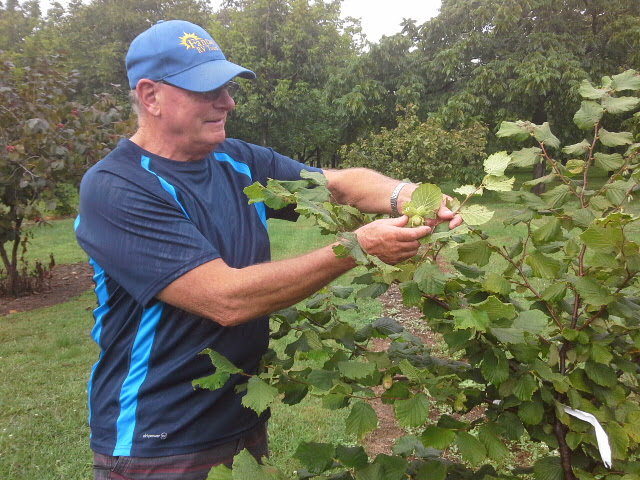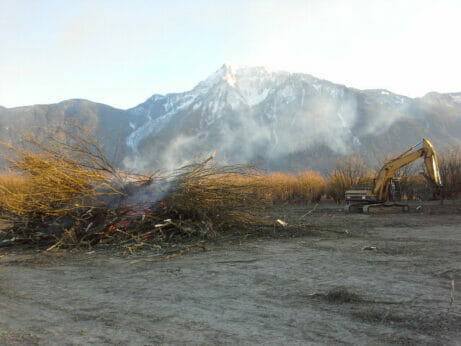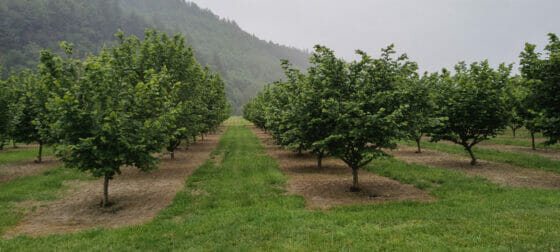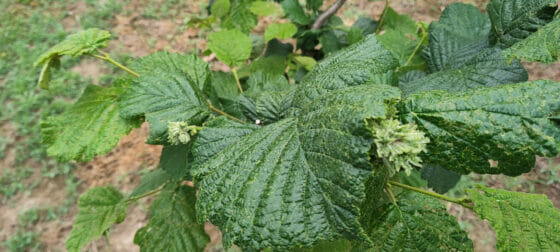Bringing Hazelnuts Back from the Brink
How farmers in British Columbia worked to save a crucial crop from a fast-spreading fungus.
Bringing Hazelnuts Back from the Brink
How farmers in British Columbia worked to save a crucial crop from a fast-spreading fungus.

Peter Andres checks hazelnuts forming on a tree in late springby Peter Andres
The tangled pile of uprooted trees in the center of the bare, frozen field was so large it dwarfed the nearby farmhouse. In the shadow of snow-capped mountains, Peter Andres watched as the pile erupted into a crackling flame that sent a single pillar of smoke straight up into the clear blue sky.
It was the winter of 2014 and Andres, like many other hazelnut growers in the Fraser Valley region of British Columbia, was destroying the last of his hazelnut trees lost to Eastern Filbert Blight. Burning is the best way to remove infected trees, according to guidelines from B.C.’s Ministry of Agriculture, Food and Fisheries. Still, it was an emotional experience for Andres. “Getting rid of the old trees…it took a lot of tears.”

Eastern Filbert Blight, a fungal disease spread by windblown spores that ultimately destroys infected trees, had spread from the east to west coast of North America in the late 1960s, initially into Washington and Oregon, then eventually into BC. The blight was first detected in BC in 2002; immediately, it was a race against the clock to slow its spread. Andres, then president of the BC Hazelnut Growers Association, worked with a team of growers to map impacted farms, trying to predict which would be hit next. They monitored orchards for symptoms and cut down infected trees. But as the fungus kills trees from the inside out for at least a year before they show symptoms, it was a losing battle.
The goal then shifted to securing a supply of blight-resistant trees for replanting. By the time the fungus reached BC, Oregon State University had already been breeding blight-resistant varieties for more than three decades in an effort to save Oregon’s official state nut. A quarantine was put in place by the Canadian Food Inspection Agency (CFIA) in 1975 to try to keep the disease out of BC. But the quarantine also prevented the import of these new blight-resistant trees from coming into the country. It took several years, but Andres and other growers were finally given the green light to bring tree tissue culture across the border in sterile test tubes. Using this culture, trees were cloned in a lab and raised by Nature Tech Nursery until ready to plant. Andres’ orchard was among the first in BC to trial the new varieties in 2011.

Despite these efforts, the blight decimated the BC hazelnut industry. Hazelnut production declined from more than one million pounds pre-blight to around 25,000 pounds by 2017, a loss of nearly 98 percent. Andres recalls walking politicians through ravaged hazelnut orchards, making a case for government financial support to help keep the industry alive. “It’s about food security,” he explained at the time. As Andres notes, hazelnuts are the only nut grown commercially in BC, which produces approximately 90 percent Canada’s hazelnuts.
After six years, the BC hazelnut industry is finally in a period of renewal. After an initial push to attract new growers and expand the number of acres planted, and with support through the BC Hazelnut Renewal Program launched in 2018, hazelnut production is steadily increasing. The new varieties from Oregon have proven not only blight resistant but also higher yielding. “We’ve got nuts rolling off the fields,” says Zachary Fleming, president of the BC Hazelnut Growers Association. In 2021, BC produced more than 70,000 pounds of hazelnuts on around 350 acres. He’s hopeful that BC will be able to meet, if not surpass, pre-blight production levels within a decade.
The BC hazelnut industry is not a significant player in global production, nor does it wish to be. According to the United Nations Food and Agriculture Organization, Turkey is the largest supplier of hazelnuts, accounting for 62 percent of global production in 2020, followed by Italy and the United States. In North America, most hazelnuts are produced in Oregon’s Willamette Valley, with some production in Washington and BC. Oregon accounts for around 5 percent of the global production with nearly 100,000 acres planted (68,000 bearing acres in 2022). In comparison, BC hopes to reach 1,000 acres.

Ferrero Group, which makes Nutella, Ferrero Rocher and Kinder Surprise, buys around a quarter of the hazelnuts grown globally and has been looking at Canada to diversify its suppliers. While the BC Hazelnut Growers Association is open to the idea of supplying to Ferrero in the future, its focus for now is the local market. As Fleming explains, “There is enough global supply, so we aren’t looking to be a huge exporter. We want to produce BC products for BC.”
Fleming estimates that there are now around 100 growers in BC, and most of them are new. “There are a few [industry] pioneers out there who have replanted, perhaps less than five,” says Fleming. “It’s been a complete restart… so there’s a generational knowledge gap.” This knowledge gap is compounded by having to work with new varieties, which Fleming says might as well be entirely different species. “The first field I helped plant was five years ago, and we’ve made five years of mistakes.”
In addition to replanting, the lack of processing capacity was another hurdle faced by the BC hazelnut industry. With the supply of hazelnuts having dried up, the two former processing facilities in the Fraser Valley were forced to shut down. The call was answered by the Hooge family of Fraser Valley Hazelnuts Ltd. The property purchased by the family to expand its poultry production happened to be the site of a former processing facility. “All the growers that had replanted came to us and said ‘hey, can you start it up again?”recalls Kevin Hooge. “The whole future of the industry seemed to hinge on that decision.” So, the family dusted off the old equipment and got to work, gradually expanding its operation into a full processing facility that now services the entire BC hazelnut industry. Since opening in 2016, the plant has played a vital role in helping new and existing farmers get their hazelnuts to local customers.

After clearing his fields, Andres needed a fresh start. In 2016, he purchased a new farm where he planted blight-resistant trees. Eager to pass on his nearly four decades of knowledge to the next generation of growers, Andres helped form the Hazelnut Growers Collective. Today, Andres can be found at the Vancouver Farmers Market selling hazelnuts under the banner of the Hazelnut Growers Collective. He first sold hazelnuts at the market out of the back of his pickup truck on a busy Thanksgiving weekend in 1997. After the blight hit his farm, Peter thought he would have to say goodbye to his market customers forever. Through the collective, growers co-ordinate their market attendance, prices and packaging. This means that their customers have a reliable supply, while allowing the growers greater flexibility.
The renewal of the BC hazelnut industry has required persevering farmers, enterprising processors, teams of researchers, cross-border collaborations and government support. Andres reflects on the last 15 tumultuous years “People always ask me, ‘Aren’t you sad that all your trees died?’ I’m sad, but in a way, I’m not sorry. Instead of us old fogies with the old farms and old varieties, we now have new ones. The industry got reinvigorated.”
Follow us
This work is licensed under a Creative Commons Attribution-NoDerivatives 4.0 International License.
Want to republish a Modern Farmer story?
We are happy for Modern Farmer stories to be shared, and encourage you to republish our articles for your audience. When doing so, we ask that you follow these guidelines:
Please credit us and our writers
For the author byline, please use “Author Name, Modern Farmer.” At the top of our stories, if on the web, please include this text and link: “This story was originally published by Modern Farmer.”
Please make sure to include a link back to either our home page or the article URL.
At the bottom of the story, please include the following text:
“Modern Farmer is a nonprofit initiative dedicated to raising awareness and catalyzing action at the intersection of food, agriculture, and society. Read more at <link>Modern Farmer</link>.”
Use our widget
We’d like to be able to track our stories, so we ask that if you republish our content, you do so using our widget (located on the left hand side of the article). The HTML code has a built-in tracker that tells us the data and domain where the story was published, as well as view counts.
Check the image requirements
It’s your responsibility to confirm you're licensed to republish images in our articles. Some images, such as those from commercial providers, don't allow their images to be republished without permission or payment. Copyright terms are generally listed in the image caption and attribution. You are welcome to omit our images or substitute with your own. Charts and interactive graphics follow the same rules.
Don’t change too much. Or, ask us first.
Articles must be republished in their entirety. It’s okay to change references to time (“today” to “yesterday”) or location (“Iowa City, IA” to “here”). But please keep everything else the same.
If you feel strongly that a more material edit needs to be made, get in touch with us at [email protected]. We’re happy to discuss it with the original author, but we must have prior approval for changes before publication.
Special cases
Extracts. You may run the first few lines or paragraphs of the article and then say: “Read the full article at Modern Farmer” with a link back to the original article.
Quotes. You may quote authors provided you include a link back to the article URL.
Translations. These require writer approval. To inquire about translation of a Modern Farmer article, contact us at [email protected]
Signed consent / copyright release forms. These are not required, provided you are following these guidelines.
Print. Articles can be republished in print under these same rules, with the exception that you do not need to include the links.
Tag us
When sharing the story on social media, please tag us using the following: - Twitter (@ModFarm) - Facebook (@ModernFarmerMedia) - Instagram (@modfarm)
Use our content respectfully
Modern Farmer is a nonprofit and as such we share our content for free and in good faith in order to reach new audiences. Respectfully,
No selling ads against our stories. It’s okay to put our stories on pages with ads.
Don’t republish our material wholesale, or automatically; you need to select stories to be republished individually.
You have no rights to sell, license, syndicate, or otherwise represent yourself as the authorized owner of our material to any third parties. This means that you cannot actively publish or submit our work for syndication to third party platforms or apps like Apple News or Google News. We understand that publishers cannot fully control when certain third parties automatically summarize or crawl content from publishers’ own sites.
Keep in touch
We want to hear from you if you love Modern Farmer content, have a collaboration idea, or anything else to share. As a nonprofit outlet, we work in service of our community and are always open to comments, feedback, and ideas. Contact us at [email protected].by Michelle Vandermoor, Modern Farmer
July 3, 2023
Modern Farmer Weekly
Solutions Hub
Innovations, ideas and inspiration. Actionable solutions for a resilient food system.
ExploreExplore other topics
Share With Us
We want to hear from Modern Farmer readers who have thoughtful commentary, actionable solutions, or helpful ideas to share.
SubmitNecessary cookies are absolutely essential for the website to function properly. This category only includes cookies that ensures basic functionalities and security features of the website. These cookies do not store any personal information.
Any cookies that may not be particularly necessary for the website to function and are used specifically to collect user personal data via analytics, ads, other embedded contents are termed as non-necessary cookies.
I really enjoyed this story. I grew up eating Hazelnuts in Seattle, Washington. We moved to Southern California in late 1959, and I never saw another Hazelnut after moving here.
I missed them, there was never any species of nut that could compare.
I recently discovered Hazelnuts advertised on FB, and then found them at Trader Joe’s under the name “Oregon Hazelnuts”.
With all the Climate Changes, I’m hoping they continue to do well, and I salute Peter Andres for his “Never Give Up” attitude!
This is a fascinating story.
Do any of these nut growers use permacultural methods? In seeing the picture of the new hazelnut trees I imagined not and if correct wondered why.
Thank you in advance for your reply.
I live in Colorado, Denver metro. I would like to grow (start) two hazel nut trees. Can you recommend where to obtain same?